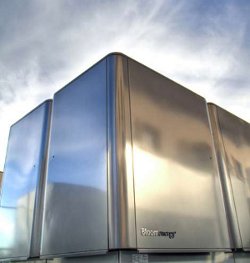Bloom Energy has stuck it out through the hard times in the fuel cell industry. It was a leader during when it first burst on the scene in 2002, and it’s stuck it out since, even as entire industry stocks have spiraled down and out of control.
But after 10 years of perpetual struggles, fuel cell companies are starting to rally, and Bloom Energy is leading the pack.
 A fuel cell, in simplest terms, is a device that converts fuels such as hydrogen, natural gas, methane, etc. into electricity via an electrochemical process with minimal emissions. Renewable energy like wind and solar provide intermittent power, where as fuel cells operate continuously.
A fuel cell, in simplest terms, is a device that converts fuels such as hydrogen, natural gas, methane, etc. into electricity via an electrochemical process with minimal emissions. Renewable energy like wind and solar provide intermittent power, where as fuel cells operate continuously.
More recently, the industry has made technological breakthroughs and is starting to attract Fortune 500 companies. An industry that consistently runs in the red is, for the first time in a long time, showing signs of profitability.
eBay (NASDAQ: EBAY) just completed a data center in South Jordan, Utah, the first facility of its kind to generate electricity solely from fuel cells that are on site – and those cells are provided by Bloom Energy.
And what’s responsible for the turnaround? The materials have completely changed. It used to be that technology would require expensive earth compounds like platinum. But that was then; companies today are using much cheaper and abundant materials like ceramics.
Factor in tax credits and rebates with other federal subsidies, and you’ve cut your total fuel cell costs in half. Now fuel cells can compete with conventional energy, and we’re starting to see it used in more states – most notably in California and New Jersey.
Between 2003 and 2011, the price of producing energy from fuel cells fell from $10,000 per kilowatt to about $2,500, according to CNBC. Revenues from stationary fuel cells grew 55 percent last year to $1.3 billion.
Bloom Energy
Bloom Energy now finds itself working closely with some of the biggest companies around, like Google (NASDAQ: GOOG), with which it has been in business since 2008. And now there’s Wal-Mart (NYSE: WMT) and AT&T (NYSE: T). It is picking up utility contracts with California’s PG&E (NYSE: PCG) and Delmarva in Delaware, a subsidiary of Pepco Holdings (NYSE: POM).
What’s more, it just began a leasing program backed by Bank of America (NYSE: BAC) that targets Fortune 1,000 companies and customers with medium-capacity needs. And it’s moved to Japan, too, signing on with Softbank (TYO: 9984) to help with its energy deficit.
In Europe, German power provider E.ON (OTC: EONGY) became a major investor in Bloom Energy as part of a financing round that raised $130 million. Credit Suisse (NYSE: CS) also contributed $30 million to Bloom.
Others with smaller contributions include Kleiner Perkins Caufield & Byers, New Enterprise Associates, Advanced Equities, DAG Ventures, and Goldman Sachs (NYSE: GS).
Bloom Energy has now raised $1.1 billion since its inception.
Bloom doesn’t disclose its finances, but expectations are that it will see a profitable year. This has led to speculation that an IPO may be in the cards in the near future, as soon as late this year or early 2014.
Fuel Cell Industry
Bloom’s biggest competition has to be FuelCell Energy (NASDAQ: FCEL), the biggest of the publicly traded U.S. fuel cell manufacturers.
The company has posted record sales, according to greentechmedia, driving down its net loss in this year’s third quarter to just $5.6 million on revenues of $53.7 million, and down from $9.9 million last year. Its backorders have reached a whopping $380.8 million. For the very first time since its IPO in 1992, it is seeing a positive spin on things.
FuelCell is also partnered up with the U.S. Department of Energy (DOE) to continue research on a sub-megawatt SOFC power plant that uses solid oxide fuel (SOFC) technology.
And in South Korea, it is currently constructing the world’s largest fuel cell park, as CNBC reports.
Our analysts have traveled the world over, dedicated to finding the best and most profitable investments in the global energy markets. All you have to do to join our Energy and Capital investment community is sign up for the daily newsletter below.
Others working with fuel cell technology include Procter & Gamble (NYSE: PG), which is converting its battery-operated forklift fleets to hydrogen fuel cells supplied by Plug Power (NASDAQ: PLUG).
Hyundai (KSE: 005380) is unleashing the first hydrogen-powered vehicle for mass production called the ix35 Fuel Cell. And not to be outdone, Toyota (NYSE: TM) claims it has cut the cost of fuel cell vehicles by 90 percent, and we could see its first hydrogen vehicle by 2015.
The other main fuel cell companies that are traded publicly, Plug Power and Ballard Power Systems (NASDAQ: BLDP), are starting to bounce back, too. Though maybe not as quickly as Bloom and FuelCell, the industry as a whole seems to be emerging from its dark side.
The Investment
That doesn’t mean they’re all in the clear just yet. A lot of these business deals and happenings are dependent on government subsidies, and if those were to be shaken up, so too would fuel cell business.
At the end of the day, the industry is shifting right along with the energy mix that is taking place on a global scale. As markets look for efficient, low carbon energy sources, it’s going to take a long time to see it all fully deployed. But change is good, and clean air is even better.
Is there a place for fuel cell technology in the future of our energy mix? I believe so.
We’re just now starting to see the proof.
If you liked this article, you may also enjoy:


